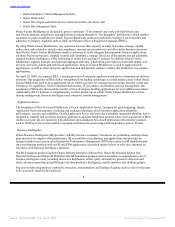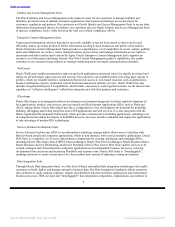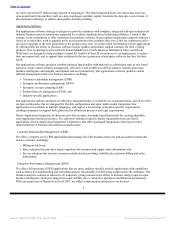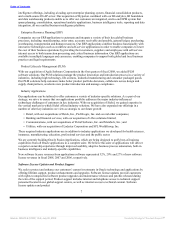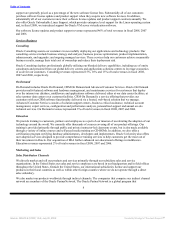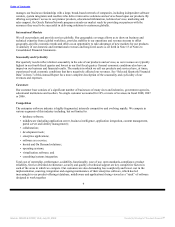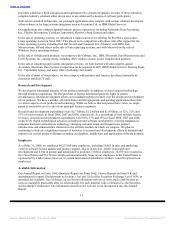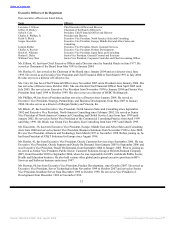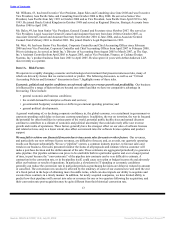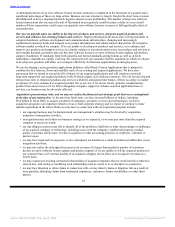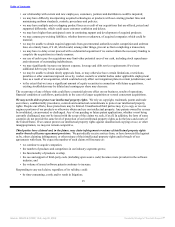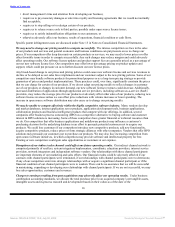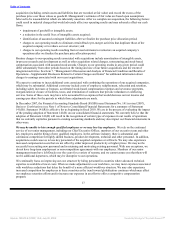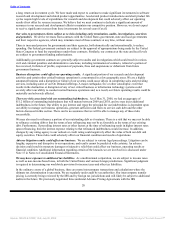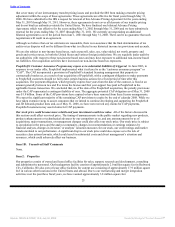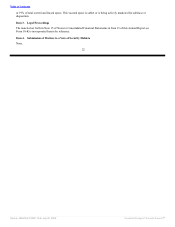Oracle 2007 Annual Report Download - page 19
Download and view the complete annual report
Please find page 19 of the 2007 Oracle annual report below. You can navigate through the pages in the report by either clicking on the pages listed below, or by using the keyword search tool below to find specific information within the annual report.
Table of Contents
A substantial portion of our new software license revenue contracts is completed in the latter part of a quarter and a
significant percentage of these are large orders. Because our cost structure is largely fixed in the short term, revenue
shortfalls tend to have a disproportionately negative impact on our profitability. The number of large new software
license transactions also increases the risk of fluctuation in our quarterly results because a delay in even a small
number of these transactions could cause our quarterly new software licenses revenues to fall significantly short of
our predictions.
Our success depends upon our ability to develop new products and services, integrate acquired products and
services and enhance our existing products and services. Rapid technological advances and evolving standards in
computer hardware, software development and communications infrastructure, changing and increasingly
sophisticated customer needs and frequent new product introductions and enhancements characterize the enterprise
software market in which we compete. If we are unable to develop new products and services, or to enhance and
improve our products and support services in a timely manner or to position and/or price our products and services to
meet market demand, customers may not buy new software licenses or renew software license updates and product
support. In addition, IT standards from both consortia and formal standards-setting forums as well as de facto
marketplace standards are rapidly evolving. We cannot provide any assurance that the standards on which we choose
to develop new products will allow us to compete effectively for business opportunities in emerging areas.
We are developing a next generation applications platform called Oracle Fusion Applications that is planned to
combine the best features, flows and usability traits of our existing and acquired applications. We have also
announced that we intend to extend the life of many of our acquired applications and will continue to provide
long-term support for our acquired products, both of which require us to dedicate resources. If we do not develop and
release these new or enhanced products and services within the anticipated time frames, if there is a delay in market
acceptance of a new, enhanced or acquired product line or service, if we do not timely optimize complementary
product lines and services or if we fail to adequately integrate, support or enhance acquired application lines or
services, our business may be adversely affected.
Acquisitions present many risks, and we may not realize the financial and strategic goals that were contemplated
at the time of any transaction. In the past four fiscal years, we have invested billions of dollars, including
$9.4 billion in fiscal 2008, to acquire a number of companies, products, services and technologies. An active
acquisition program is an important element of our overall corporate strategy and we expect to continue to make
similar acquisitions in the future. Risks we may face in connection with our acquisition program include:
• our ongoing business may be disrupted and our management’s attention may be diverted by acquisition,
transition or integration activities;
• an acquisition may not further our business strategy as we expected, or we may pay more than the acquired
company or assets are worth;
• our due diligence process may fail to identify all of the problems, liabilities or other shortcomings or challenges
of an acquired company or technology, including issues with the company’s intellectual property, product
quality or product architecture, revenue recognition or other accounting practices or employee, customer or
partner issues;
• we may have legal and tax exposures or lose anticipated tax benefits as a result of unforeseen difficulties in our
integration activities;
• we may not realize the anticipated increase in our revenues if a larger than predicted number of customers
decline to renew software license updates and product support, if we are unable to sell the acquired products to
our customer base or if contract models of an acquired company do not allow us to recognize revenues on a
timely basis;
• we may assume pre-existing contractual relationships of acquired companies that we would not have otherwise
entered into, and exiting or modifying such relationships may be costly to us or disruptive to customers;
• we may face litigation or other claims in connection with, or may inherit claims or litigation risk as a result of,
an acquisition, including claims from terminated employees, customers, former stockholders or other third
parties;
14
Source: ORACLE CORP, 10-K, July 02, 2008 Powered by Morningstar® Document Research℠


